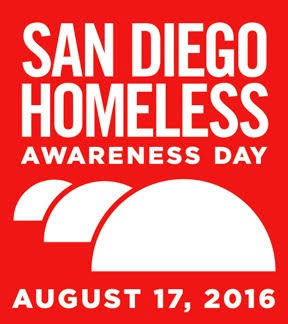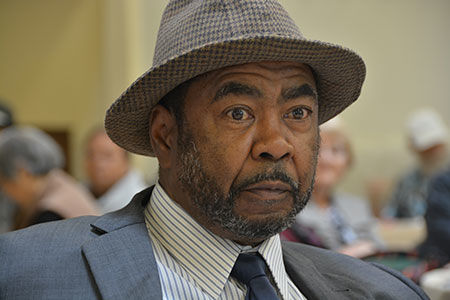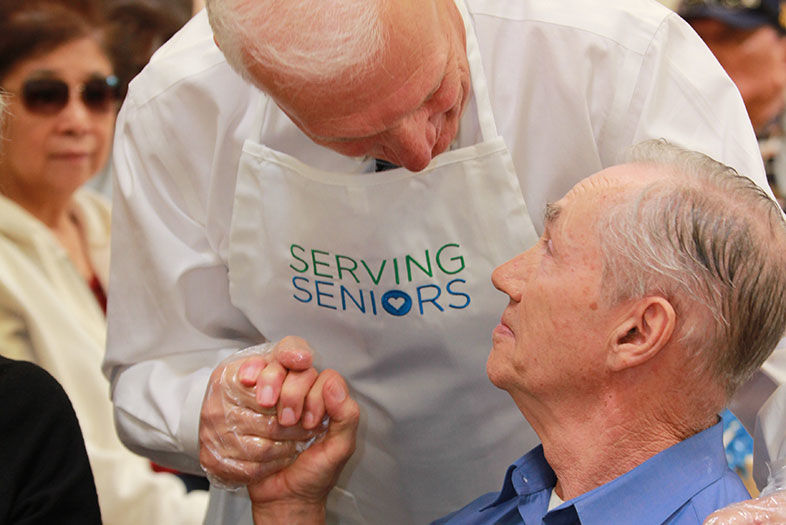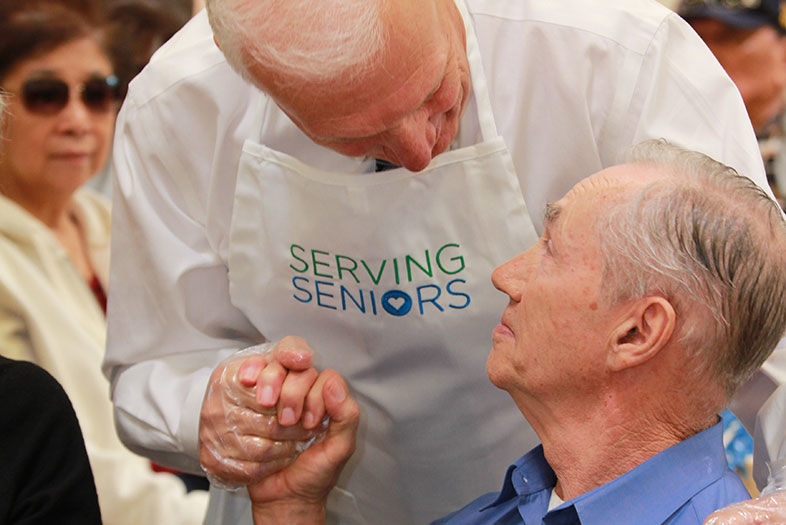
“We’re All One Misfortune Away from Becoming Homeless”
San Diego Magazine is among more than a dozen media outlets posting stories on the issue of homelessness as part of San Diego Homeless Awareness Day on Wednesday, August 17, 2016. It’s a crowdsourcing approach. With stories in print, on TV, radio, and online, San Diego journalists tackle this tough topic from multiple vantages. To follow the coverage, follow San Diego Homeless Awareness Day on Facebook, Twitter and with the hashtag #HomelessinSD. Here’s our look at local homeless programs that are making a difference.
The low-income seniors who enter the doors of Serving Seniors’ Gary and Mary West Senior Wellness Center come from diverse backgrounds and circumstances. There is no one route to becoming one of San Diego’s most vulnerable, at-risk citizens.
Brent Wakefield, chief development officer for Serving Seniors, tells stories of seniors seeking help who suffered a job loss, a health crisis, or who just didn’t have any other family members left.
“These are people I would love to have as a grandmother or mom,” Wakefield says. “It’s a broad range of people. What they all share in common is poverty.”
Serving Seniors offers adults ages 60 and older meals, education, social services, case management, and affordable housing options. The idea is to keep them as healthy and independent as possible.
The wraparound services help pull many seniors back from the precipice of homelessness, says Molly Cartmill, Serving Seniors’ board chair and director of corporate social responsibility for Sempra Energy. It’s estimated that 2 in 5 seniors must choose between rent and food.

What’s Working: Preventing Homelessness in San Diego’s Seniors Takes a Comprehensive Effort
“It is unacceptable, in my opinion, to allow fragile seniors to fall into that hole,” Cartmill says, recalling a couple in their 80s who were evicted and had nowhere else to go. “They say that society is judged by the way it cares for its most fragile citizens. Everyone deserves dignity and respect.”
For those seniors who do become homeless or are facing eviction, Serving Seniors offers a Homeless Prevention Program. The seniors are connected with case managers who assess their needs to help them find meals, counseling, and affordable housing at one of the program’s two senior residential facilities. The waiting list for just a handful of available single-occupancy housing units can be two to three months long, according to social service case manager Pamela Alvarado.
In the decade since its creation, Serving Seniors’ homeless support program has served more than 1,000 seniors, with a 92-percent success rate.
The Regional Task Force on the Homeless has counted San Diego County’s homeless population at nearly 8,700 people, of which 4,940 are without shelter. Of that unsheltered population, 1,334 people, or 27 percent, were over the age of 55.
Cartmill estimates that’s a 167-percent increase in homeless seniors in the last year alone.
“I can’t believe people aren’t freaking out about that number,” says Wakefield.
Cartmill says our aging Baby Boomer population will undoubtedly increase the number of seniors at risk of homelessness.
Serving Seniors is the only organization of its kind in San Diego working specifically with homeless seniors. Wakefield says there are a number of ways concerned San Diegans can get involved, from corporate giving to serving meals to supporting expanded housing opportunities region-wide. Awareness of San Diego’s older homeless community is an important first step, he says. “It’s a growing population. The numbers are scary.”
Varied approaches for a varied population
Seniors are but one demographic of San Diego’s diverse homeless population. The Regional Task Force on the Homeless says that 59 percent of San Diego’s unsheltered homeless are between the ages of 25 and 54. Nearly 72 percent are male, 60 percent are white, and 39 percent have a physical disability. Some 22 percent of the unsheltered are considered chronically homeless, defined by the U.S. Department of Housing and Urban Development as someone who’s been homeless for a year or more.
There are a range of approaches to helping this varied population, from expansive, multi-agency assistance programs to grassroots volunteer groups.
One of the larger local initiatives is Project 25, a public-private partnership overseen by Father Joe’s Villages. Its aim is to help chronically homeless people, who are the most frequent users of costly, publicly funded services like emergency room visits and ambulance rides. Project 25 has helped about 40 participants with subsidized permanent housing, case management, and medical care, resulting in an estimated savings to taxpayers of more than $4 million.
“These are people who are costing the system a lot of money, often with physical or mental health issues. But with stable housing and health care, they’re not as costly,” says Ruth Bruland, Father Joe’s Villages’ chief program officer.
These are people who are costing the system a lot of money, often with physical or mental health issues. But with stable housing and health care, they’re not as costly.
With help from local hospitals, ambulance services, law enforcement, and homeless shelters, Project 25 identifies and reaches out to those most in need.
“It’s an incredibly sad thing that the most welcoming place these people can find is an emergency room,” Bruland says.
Project 25 is so named because it initially sought to house at least 25 chronically homeless people with federal housing vouchers and $1.5 million in startup funds from the United Way.
The United Way provided another $100,000 in bridge funding for the program, but is no longer financially involved. Father Joe’s Villages now operates Project 25 with private donations and grant money from the U.S. Department of Health and Human Services Substance Abuse and Mental Health Services Administration.
“Project 25 has been this tremendous lesson for all of us,” Bruland says. “Homelessness never ends, but it’s our job to keep plugging away. This has taught us to never give up. You just have to find the right combination of intervention, then—oh my gosh—miracles happen.”
Not all efforts to help the San Diegans who are most in need are large scale. Some are as straightforward as a humble breakfast burrito. Michael and Mehrnaz Johnson began Hunger 2 Help Inc—known in San Diego’s East Village as the “Burrito Boyz“—with their son Alec and his friend Luke as a way to teach the boys about being grateful and altruistic.
They served 54 hot breakfast burritos and bottled waters to the hungry on their first Sunday in 2010. The original boys are off to college, but the nonprofit Burrito Boyz is now powered by a rotating cast of youth groups who spend every Sunday distributing breakfast burritos, toiletries, pet supplies, books, resource guides, and donated food from corporate givers like Panera Bread and Einstein Bros. Bagels. The number of hot meals served so far: 135,201 and counting.
Burrito Boyz serves the homeless, but also those on the brink, says Michael Johnson, president of Burrito Boyz and vice president of development for the San Diego Rescue Mission.
“A lot of the people that we feed are indoors, but they might have already used every available resource. So we help the needy as well as our homeless community,” Johnson says.
The Burrito Boyz rely heavily on youth volunteers, from scout packs to sports teams, as well as the donated kitchen of Long Island Mike’s Pizza in Tierrasanta, and on private donations.
“I tell our volunteers almost every Sunday that we’re not trying to solve the problem of homelessness. I think everybody deserves a meal, a bottle of water, dignity, and hope and love,” Johnson says.
More in Homeless Awareness Day:

What’s Working: Preventing Homelessness in San Diego’s Seniors Takes a Comprehensive Effort
John Currie, shown here with San Diego County Supervisor Ron Roberts, secured housing through Serving Seniors’ Homeless Prevention Program. He’s now a volunteer and advocate for the program.
















